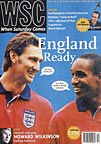 Many Scottish clubs are looking to move, but Gary Oliver reports on why this may not be good for them
Many Scottish clubs are looking to move, but Gary Oliver reports on why this may not be good for them
Anyone attempting to visit the homes of all 92 English league clubs during the 1990s has been faced with a moving target. In Scotland, where far fewer new stadiums have risen, it is several nomadic clubs that have been doing the groundhopping – an experience from which not one has benefited.
In 1986 Clyde, then based in south-east Glasgow, became the first Scottish club of modern times to leave its traditional home. The Bully Wee spent almost a decade on the road, initially at Partick’s Firhill in the north of the cit before decamping to Douglas Park in Hamilton. Clyde’s support in Glasgow had been loyal, if understandably small given their old ground’s proximity to Celtic Park. But in the years after leaving Shawfield, which was better known for hosting greyhound racing, the team also went to the dogs.
Lodging at Partick and Hamilton meant some embarrassingly small attendances and relegation to the bottom division, when it came, was overdue. In 1994, however, the club secured long-term tenancy of the new Broadwood Stadium in Cumbernauld. To great fanfare, Clyde assembled a full-time squad, brought in as manager the former Aberdeen boss Alex Smith (later sacked) and awarded a fat playing contract to Charlie Nicholas, who retired after one season.
The Cumbernauld public was initially curious, but interest soon waned when the team failed to progress upwards as had been expected. The irony is that Clyde, evenutally forced into austerity measures, last season did unexpectedly well with a part-time team plucked from the Junior leagues.
Joining Clyde at Broadwood for several seasons were Airdrieonians, who vacated their Broomfield home in 1994. The Diamonds’ Dad’s Army line-up appeared to thrive in adversity, enjoying some notable Cup successes. Yet only hardcore supporters made the short journey to Cumbernauld, that being at least part of the reason why the team always seemed more formidable away from “home”.
Now back in Airdrie at the snappily named Shyberry Excelsior Stadium, it had been assumed that absent locals would return. However, it appears that some erstwhile fans, after four years away, have gone for good, and an astonishing ten home defeats last season did nothing to entice back any waverers.
Becoming vagrants at the same time as Airdrie were Hamilton. But whereas Accies’ Lanarkshire neighbours eventually made it home, Hamilton’s proposed new stadium, adjacent to their old Douglas Park, remains a dream. Supporters have long been outraged by murky goings-on in the boardroom, memorably fingering the guilty men on one occasion with a satirical puppet show in front of the directors’ box.
Nor have fans had much to cheer on the park. In 1992 only goal difference prevented Accies from retaining Premier status, but by 1999 they were propping up the Second Division. Playing home matches at Partick’s Firhill (where they still reside), with a minuscule support, put Hamilton at a huge disadvantage when in the First Division – though cynics might say that an even greater handicap was the employment for three years of Iain Munro, a manager notorious for his non-Midas touch.
Accies also endured a torturous interlude at Albion Rovers’ ramshackle Cliftonhill, seldom knowing from one week to the next whether the place had safety clearance. In spring 1998 a fixture was postponed because the council had still to check the tea-urn, kettle and other humdrum electrical appliances – hilarious, had I not been one of the Raith supporters due to attend.
Hamilton and Clydebank – who, after considering Dublin, Carlisle and Galashiels, finally pitched their tents in Greenock – are currently Scotland’s only vagabond clubs. But several First Division teams will also have to find temporary lodgings if they are to enter the SPL next season. The speculation is that Ayr United, whose planned relocation has been stalled by a public inquiry, would seek to share with St Mirren at Paisley, almost an hour’s drive away. Falkirk’s chairman claimed in the press to have agreed in principle a groundshare at, yes, Cumbernauld again.
Sitting tenants Clyde immediately dismissed the idea out of hand, while Falkirk’s retort was that any decision is for the owners, North Lanarkshire Council, alone. Yet no party has so far addressed the fact that three-sided Broadwood, holding only 8,200, currently falls short of the SPL’s 10,000-seat criterion.
Opened with just two stands, one along either touchline, Broadwood Stadium was initially akin to a wind tunnel. We may experience plenty more hot air before Falkirk talk their way into a groundshare acceptable to the SPL.
From WSC 154 December 1999. What was happening this month